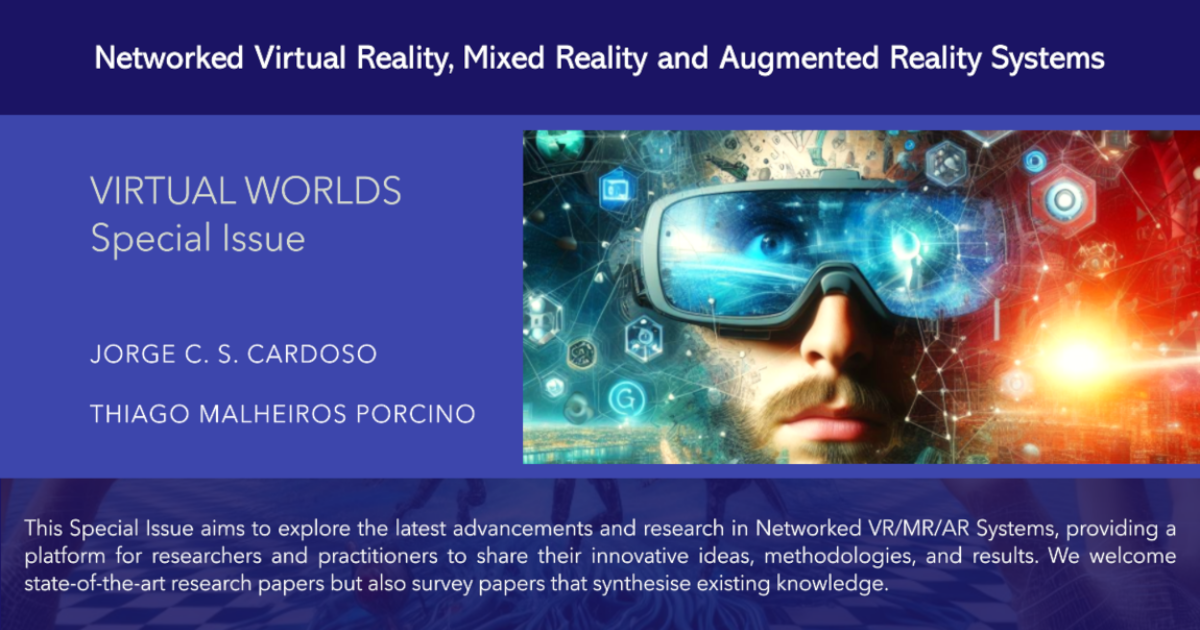Networked Virtual Reality, Mixed Reality and Augmented Reality Systems
A special issue of Virtual Worlds (ISSN 2813-2084).
Deadline for manuscript submissions: closed (30 November 2024) | Viewed by 24779

Special Issue Editors
Interests: human-computer interaction; virtual and augmented reality; tangible user interfaces; interaction techniques; interaction design
Special Issues, Collections and Topics in MDPI journals
Interests: virtual reality; mixed reality; augmented reality; extended reality; human-computer interaction; machine learning; serious games
Special Issues, Collections and Topics in MDPI journals
Special Issue Information
Dear Colleagues,
Virtual Reality (VR), Mixed Reality (MR), and Augmented Reality (AR) have emerged as transformative technologies with the potential to revolutionise various domains, including entertainment, healthcare, education, tourism, industry, etc.
Many of these systems are local, single user and provide individual experiences. Networking can further enhance the capabilities and possibilities of these technologies by allowing for multi-user environments but also for remote rendering and telepresence. Networked VR/MR/AR systems also bring new challenges, technical, and social issues, and concerns.
This Special Issue aims to explore the latest advancements and research in Networked VR/MR/AR Systems, providing a platform for researchers and practitioners to share their innovative ideas, methodologies, and results. We welcome state-of-the-art research papers but also survey papers that synthesise existing knowledge.
Topics of interest include, but are not limited to:
- Networked VR/MR/AR frameworks and architectures;
- Multi-device VR/MR/AR systems;
- Multi-user interaction and communication in networked environments;
- Networked interaction techniques;
- Networked haptic feedback and sensory augmentation;
- Remote rendering for VR/MR/AR;
- Networking protocols and infrastructure for VR/MR/AR;
- Cloud-based VR/MR/AR systems;
- VR/MR/AR for remote collaboration and telepresence;
- Human–computer interaction in networked VR/MR/AR;
- Applications of networked VR/MR/AR in healthcare, education, gaming, and beyond;
- Networked authoring systems, programming libraries, toolkits, and framework;
- Multi-device collaboration in networked extended reality environments.
You may choose our Joint Special Issue in Applied Sciences.
Dr. Jorge C. S. Cardoso
Dr. Thiago Malheiros Porcino
Guest Editors
Manuscript Submission Information
Manuscripts should be submitted online at www.mdpi.com by registering and logging in to this website. Once you are registered, click here to go to the submission form. Manuscripts can be submitted until the deadline. All submissions that pass pre-check are peer-reviewed. Accepted papers will be published continuously in the journal (as soon as accepted) and will be listed together on the special issue website. Research articles, review articles as well as short communications are invited. For planned papers, a title and short abstract (about 250 words) can be sent to the Editorial Office for assessment.
Submitted manuscripts should not have been published previously, nor be under consideration for publication elsewhere (except conference proceedings papers). All manuscripts are thoroughly refereed through a single-blind peer-review process. A guide for authors and other relevant information for submission of manuscripts is available on the Instructions for Authors page. Virtual Worlds is an international peer-reviewed open access quarterly journal published by MDPI.
Please visit the Instructions for Authors page before submitting a manuscript. The Article Processing Charge (APC) for publication in this open access journal is 1000 CHF (Swiss Francs). Submitted papers should be well formatted and use good English. Authors may use MDPI's English editing service prior to publication or during author revisions.
Benefits of Publishing in a Special Issue
- Ease of navigation: Grouping papers by topic helps scholars navigate broad scope journals more efficiently.
- Greater discoverability: Special Issues support the reach and impact of scientific research. Articles in Special Issues are more discoverable and cited more frequently.
- Expansion of research network: Special Issues facilitate connections among authors, fostering scientific collaborations.
- External promotion: Articles in Special Issues are often promoted through the journal's social media, increasing their visibility.
- Reprint: MDPI Books provides the opportunity to republish successful Special Issues in book format, both online and in print.
Further information on MDPI's Special Issue policies can be found here.





